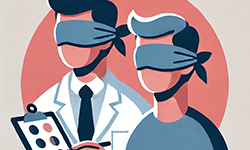
Bias is one of the greatest barriers to effective research, so double-blind study designs have become a core part of gold-standard trials in methodology. This design blinds the researcher and the subject until the end of the trial, thereby preventing certain types of research bias in either party. This article will cover any important information about double blinding, its types, uses, and effects.
Definition: Double-Blind Study
The double-blind study design masks information from both researchers and subjects to reduce the odds of bias. Blinding reduces the chance of test subjects developing placebo effects, while preventing researchers from consciously or unconsciously altering their participants’ perceptions. This way, studies can be replicated easily without losing validity.
Masking also reduces the chance of test subjects developing placebo and nocebo effects, while preventing researchers from consciously or unconsciously altering their participants’ perceptions.
Even so, double-blind study procedures aren’t the zenith of masking. Trials can be triple or even quadruple-blind.
Types of blind studies
Generally, there are three common types of blinding applied in research:
- In single-blind studies, only the participants do not know which group they are in. The researcher or doctor in clinical studies knows which treatment you are receiving.
- Double-blind studies are the most common variation, meaning that neither the participants nor the researcher or doctor know who is in which group. Only the data analysts will know.
- In a triple-blinded study, the participants, researchers, and data analysts do not know who is treated how. Participants are assigned into groups 1 and 2 and the data is analysed obliviously. This type of study is used very rarely due to its complicated procedure, but it may help in cases, where data analysts might be influenced by bias or prejudices.
The importance of a double-blind study
Double-blind studies are important in order to avoid research bias and unblinding in a study. When neither the researcher nor the participants know which treatment they are receiving, the inner validity of the study is protected.
They can also lead to biased reporting and alter the way doctors perform disease assessments.
Bias can be both intentional and accidental, so pure motives aren’t enough. Double blinding protects the integrity of the researcher and lends weight to their results, providing a smoother peer review process.
While it can be difficult to conduct a double-blind study, if the experiment is only single blinded, it is more likely that participants will find out about their assigned group and thus alternate their behaviour. If the participant finds out about receiving the real treatment or fake treatment, this is called “unblinding”.
In other cases, however, blinding might be impossible, especially in physical treatment. You may be able to give placebo sugar pills to participants, but you cannot fake physical exercises or treatments without affecting the individuals in any way.
FAQs
Besides the double-blind study, where neither the researcher nor the participants know who is in which group, there are also the single-blind study and the triple-blind study. In a single-blind study, only the participants are blinded while in a triple-blind study, even the data analysts do not know about the treatment each person receives.
In a double-blind study, only the director of the research and the independent data analysts know who receives which treatment.
While double-blind studies are widely used in research, in cases where there is physical treatment involved or in psychological studies where the researcher bases his data on the personal interaction with participants, double-blinding is hardly possible.
